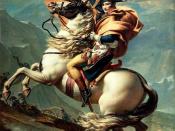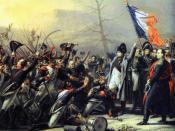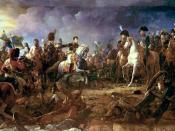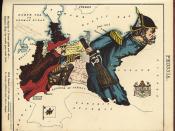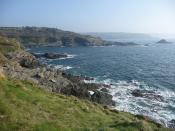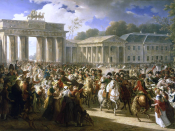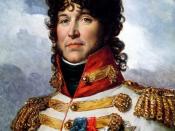Europe, the Nineteenth Century has just begun, Napoleon has been crowned Emperor of the French. This however does not sit well with the other major powers in Europe.
Great Britain fearing invasion has formed a coalition against their long-time enemy: France. In 1805 Napoleon defeated the Russians and the Austrians in the battles of Ulm and Austerlitz, givng him power to change the borders of the map as he saw fit. In 1806 Napoleon caused the collapse of the Holy Roman Empire, which had lasted for over a thousand years. At the same time he formed the Confederation of the Rhine, which served as a garrison for his Grande Armee.
This was a direct insult to the Kingdom of Prussia, which until that point had been neutral. In September, 1806 King Frederick III mobilized his army, giving Napoleon an ultimatum. Frederick III demanded the immediate withdrawal of French forces from the German states.
Napoleon's response; he ordered his armies to advance on the Prussians at once. If Napoleon succeeds, all of central Europe will be under his control.
Campaign plans were going on for quite some time, Napoleon chose 7 brave and outgoing men to lead his infantry corps, these were the Marshals: Bernadotte, Davout, Soult, Lannes, Ney, and Augereau. Marshal Murat was in charge of the cavalry. (in French you usually do not pronounce the last part of a word)According to plans they would take separate routes to Berlin, force the Prussians and allied Saxons into 1 decisive battle. They were going to attack swiftly so as not to give the Prussians a chance to assemble against them. Each corps had 25000-20000 men that can each operate as an individual army. The leader of the 175000 invasion force was under the direct command of Napoleon himself.
Frederick did not claim to be much of a tactician; therefore he turned over command to Duke van Braunschwieg. Who had previously fought in the French Revolution. Count Tauentzien commanded the left wing, Prince Hohenlohe on the right. Ruchel the flanking corps and Count Kalkreuth commanded the reserve. Size and formation depended on the officer's rank and status. The order of battle was all but settled and was changed on numerous occasions.
The bulk of the allied Saxons were commanded by general Zezschwhitz, Blucher was in charge of the Prussian rear guard The Duke Sachsen Weimar and the Prussian Prince Louis, who was the only commander under the age of 40.
The Prussians would advance two detachments on both sides, the larger force would head to the north, to counter the French advance.
Meanwhile the French begin their march, heading northeast taking 3 separate roads, each army is only a days march from each other. With Napoleon in the center marching with his Imperial Guard. Napoleon receives a constant stream of new reports from each army.
The first confrontations with the Prussians take place at Auma, Saalfeld, and Schieltz.
The position of the Prussian army is instantly obvious to Napoleon, he issues a hard left turn and orders his officers to focus on the river crossing, here is where the first major battle will take placeIt is November 14, 1806 5:00 AMJena, a small university town in central Germany, the French are on the edge of the plateau west of Jena. Most of Napoleon's army are veteran soldiers from the battles at Ulm and Austerlitz from the war before, the are supported by the Imperial Guard, more battle experienced and the most loyal to Napoleon. Soult advances on the right, Lannes at the center, left of him is Augereau. Ney follows in a second line to deploy in a proper battle formation. The French's path leads them along a narrow ridge that leads to the high plains west of them. They advance with all units in tight formations marching along the ridge, they must hurry to reach the high plains and close their exposed left flank, and fill the gap.
French Count Surrey reports:"The night brought dense fog; this could not have been more favorable, because we were in close lines and in a small area. Their cannons fired in the direction of our fires the night before, but because of the fog casualties were low. Fortune was on our side"Some quickly assembled Saxons and Prussians try to resist the massive French advance, but they can no longer hold their position.
On all sides French forces curl up along the ridge, in a coordinated large-scale assault the French seize the heights and repel the first ranks of Prussians and allied Saxons. Messages of this are received no earlier than 9:00 'o clock that morning at the Prussian headquarters only 8 kilometers away. However Prussian officer Hohenlohe is not yet ready for military action.
Officer Guarde, a subordinate of Hohenlohe rallies a small division of troops and march to secure their open flank.
Napoleon has now gain control of the plains, the left wing of the Prussians has been separated, and driven away from the battle. Napoleons' plan proves to be a success. He also has obtained many Prussian cannons.
A few miles away Prince Hohenlohe is outraged, his army had marched on without his consent. He orders Guarde to hold his position, until the reason for this insubordination is clarified. Guarde is able to convince Hohenlohe that a decisive battle is about to start.
Meanwhile Napoleon orders a halt as well, the fog made it too risky to continue. Therefore he sends a scouting party and waits.
Hohenlohe orders his men to deploy to defensive battle line, all Prussian units receive their coordinates.
Once Hohenlohe's men are in position the get in touch Prussian units that had been beaten back in the early fighting. Their faces are filled with desperation. This does not make a good impression on the new troops.
Prussian officer Noundwer reports:"The platoons were first dispatched in columns, all officers were dismounted. The drummers were drumming and the pipers were playing. We marched into deployment zone. The officers on the flanks, then we stopped to deploy the formation."The most commonly used formation in Napoleonic times was the line formation, consisting of three rows.
"Once the divisions were in position, the platoon marched forward, we loaded our muskets as we marched."There are documents that report musket loading and marching, loading a musket alone is a long and difficult process, yet the disciplined Prussian army managed to do this while still staying in formation.
"I was right behind the formation, with an officer of the Fusiliers from the neighboring battalion. We shook hands, and promised to support each other in the bravest manner. A moment later Prince Hohenlohe himself appeared; riding up the line of the left flank. The soldiers of each battalion cheered as he rode by. All my troops were in high spirits. Their cheers ring in my ears to this day, the enthusiasm shown by my men made me proud."The silhouette of the church in the village of Vierzehnheiligen is identified, Hohenlohe stops to let the fog sink in.
Hohenlohe has orders from Duke van Braunschwieg not to accept any engagement to the enemy, and to draw back off of the enclosing enemy. His mission is to screen the main army that is operating only 30 kilometers away in Jena. Hohenlohe does avoid the attack, however he chose to take resistance.
His close lines guarantee maximum firepower, Napoleon has advanced his infantry to the village as well. They plan to make contact with the Prussians.
"On the crest of the hill we could see part of the French army engaged with our vanguard. Several French were beginning to spread over the field ahead of us, some of them even moved closer than 50 feet of our regiment. Our cannons had unlimbered some distance ahead of us; and were firing at Vierzehnheiligen."A squadron of French cavalry attack a Prussian cannon outpost and seize it. Perhaps because of the unexpected fire coming from the friendly cannons two squadrons of Prussian cavalry break the line. Deserters had to be stopped by a volley of gunfire according to Prussian regulations.
"They refused to fire! The men were clearly confused, as was made obvious by the astonished cry of one officer: 'sir, we are to fire on our own men?' Apparently he believed we had mistaken them for our enemies."By then the cavalry is under control, however the impact on Prussian morale could not be fixed.
"By this time we had lost confidence in our cavalry they were held back for the rest of the day. They were not even placed with a purpose or plan, and no single officer was given command. We were beginning to take noticeable losses. Because of the thick curtain of fog made the enemies' position almost invisible to us. Our lines fired volley after volley often without a target to shoot at. The enemy occupied the village buildings, making it impossible to approach. We were lined up a few hundred feet from their artillery batteries. Canister fire swept through our ranks leaving gaps of devastation, which we could not fill. The field in front of the village entrance was a horrible bloodbath. The enemies primary target were the officers, however these held firm until the order to fall back was received."Prussian officers were expected to command their troops regardless of the situation. To disobey their superiors would be considered an act of desertion. All they could do was order volleys at the village, but where is the Prussian cavalry?"Our cavalry was lined up alongside the infantry! They held out the canister fire until they could bear it no longer. Finally the artillary was granted permission to use incendiary grenades, the village was soon aflame. The enemy was forced out of the buildings."Napoleon still believes that he is facing the main army, but he has doubts, he constantly looks through his telescope, waiting for his reinforcements. He tries to spot an opening in the fog, which is finally lifting, though only reluctantly.
Marshal Lannes's corps is placed out of enemy sight, that corps amounts to 25,000 men. Also there are 60,000 men maneuvering into position. Both units are ready for a decisive assault.
"Our artillery was wreaking havoc on the village, the surviving skirmishers fell back to their corps, an for a short while the battlefield was calm. By the constant peppering fire from the skirmishers the enemy had been screening their main armies' operations. As we fought at the village the enemy deployed in such a way that we would be unable to see their position. Meanwhile the Saxons were idle at our flanks. From their position south of Isserstedlt, they must have been able to see the enemy's hidden operations.""We were forced to see a shocking scene. The village was almost burning to the ground. Yet we were very pleased to see that our Prussian allies had mastered the situation. However, more enemy troops were forming up."By 11:00 o' clock weather conditions finally began to improve. As the battlefield cleared so did Napoleon's mood as well, Napoleon orders his corps to attack on all points.
Marshal Soult has scattered the left wing, instead of chasing them off the battlefield he wheels left towards Hohenlohe's left flank. Same time, Marshal Ney's corps have arrived and are assisting Marshal Lannes's attack on the center. Augereau's corps pushes through the woods and attacks the Prussian right wing. French manpower has just increased 4-fold, it is now twice as powerfull as the Prussian force opposing it.
Now Marshal Murat's corps of heaby cavalry has arrived, their trumpets announce the hunt that will soon follow. To anyone wearing a Prussian uniform, there is nothing left to do accept escape as fast as possible.
No earlier than the final phases of the battle does Napoleon realize that he had not been fighting the main Prussian Army, this was actually a strong detachment. Where is Braunschwieg's main army? What had happened to Marshal Davout? He was ordered to flank and surprise the enemy as he had done previously during the Austrian Campaign the year before.
Davout had taken the road over Apolda and Auerstedt heading southwest, his force amounts up to 25,000 men. On the same road the main Prussian army is heading towards it's headquarters. They number more than 60,000 men. Now there will be a second major battle known as Auerstedt.
Both armies are unaware of the other, French officer reports:"Because of the fog it was impossible to see anything beyond pistol range. Marshal Davout had sent Colonel Burke to scout the area with enemies with a small force of cavalry. It was Burke who had spotted the Prussian advance guard under the command of General Blucher. They also identified the Prussian King, who was riding ahead of the colomns.
The Prussians have received the news of the threat as well, although the Prussian King is a cautious man, military decisions are in the hands of Duke van Braunschwieg, who does not view the French forces as a threat. Blucher is granted permission to use a cavalry assault and clear the way for the rest of the army. He gathers up the 10 divisions of cavalry and starts the assault. He plans to rush the French colomns and overwhelmthem with speed and suddeness. After a brief struggle Blucher drives back the French scouts, as they flee they pass Davout's colomn; informing them of the impending attack. Davout immediatly orders his men to form squares. In only half a minute the French colomns have transformed to squares. Artillary batteries are placed at the corners, and bayonets are planted and prepared for the enemy. The clash of the feared Prussian cavalry against the finest French infantry emerges. Each musket contains a steel ball ready to kill. But the men must stay calm and steady, they allow the Prussian cavalry to envelop the squares. They cavalry surround the squares and vigorously pick at the squares, trying to find a weak point. Each time the cavalry charge, the French respond with a volley of bullets. Again and again the Prussians are repelled by the French squares,The whole operation ends in a miserable failure, Prussian casualties are absolutley devastating.
In only two battles, the French were able to destroy the Prussian and allied Saxons and ensure victory, but what price was paid? More than 50,000 men were killed in the battles of Jena and Auerstedt. The Prussians had been unable to adapt to modern warfare tactics, they relied on strategies that had worked in the past. By constantly reusing old tactics Napoleon could easily predict what the Prussians were planning. Even Davout could tell that the Prussians had launched a cavalry charge just by seeing the fleeing scouts.
1806 is known as the climax of Napoleon's career. Thanks to historians around the world, we can so clearly see these events. However we may never know what events such as Jena and Auerstedt meant to the victims, what impact it had to those actually present at that time. What of their thoughts and feelings that day on November 14? How can one ever claim to know?Sources:Wikipediawww.historyworld.netwww.bbc.co.uk
